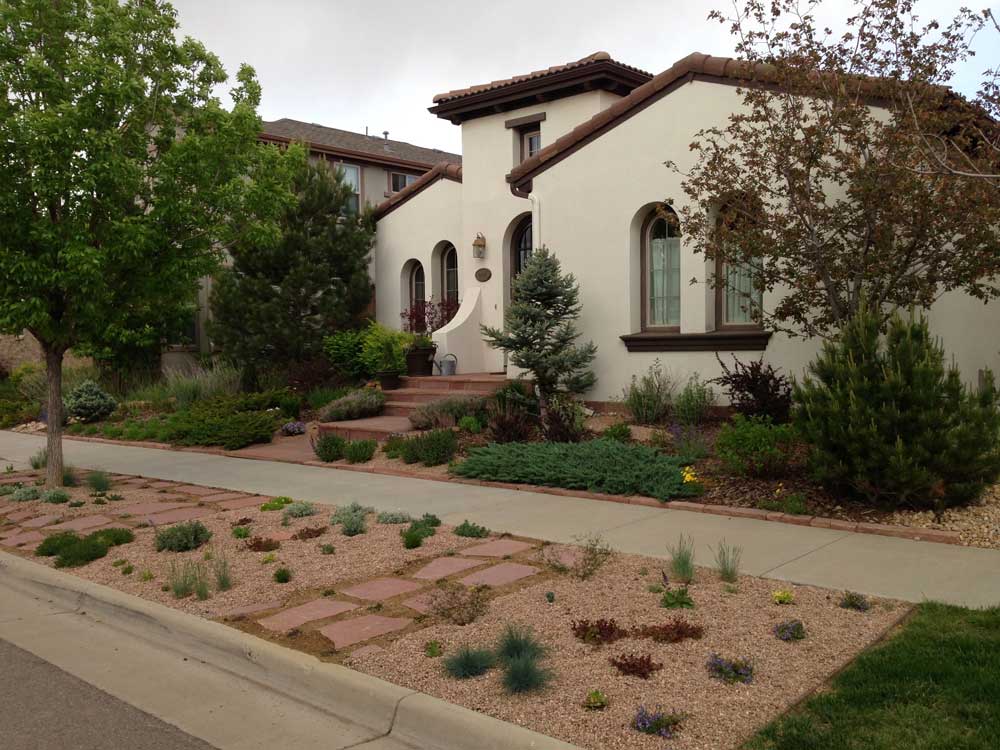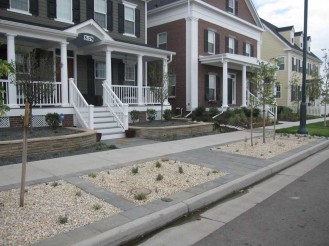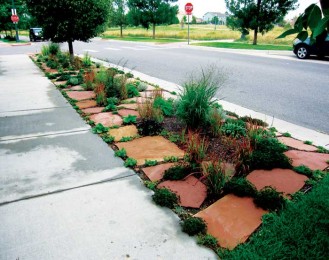
Hardscape materials & plantings were chosen to complement the architecture of this Spanish style home. Designed by Sarah Christian, RLA.

Pennsylvania blue stone was chosen to complement the house color and traditional architectural style while plantings are more regionally appropriate. Designed by Sarah Christian, RLA.
The rectangular piece of lawn between the sidewalk and the street was historically known as the tree lawn but has also been referred to as the median strip, parking strip, right of way, boulevard and “hell strip.” Colorado horticulturist and author Lauren Springer said in a 2010 New York Times article, “It’s a strip and it’s hellish. It’s hard for plants to grow there.” She listed the hardships of the hell strip, which include dog waste, snowpack, road salt, and reflected pavement heat that can reach 150 degrees at ground level.
In historic Denver, parkways such as those along 17th Ave., Monaco Blvd., and 6th Ave. had beautiful tree lawns that provided continuity in the streetscape with one lawn flowing into the next all the way down the block. Susan Baird, planner for Denver Parks and Recreation, said in a CSU Extension publication, “Since Denver’s earliest days, planted tree lawns have provided the aesthetic character that ties neighborhoods together. It’s the visual rhythm of green trees above that frame a space below, complemented by a continuous, horizontal green tree lawn that gives Denver its distinctive character.”
As beautiful as these spaces are, periodic drought, runoff tainted by chemicals and growing population in the semi-arid West calls into question the sustainability of this historic aesthetic. Susan recommends using masses of silver-leafed and other color plants. “Our modern definition of green has expanded beyond bluegrass to add richness to our urban design.” By tying your strip to your region, you give it a sense of place and make it more sustainable.
If you are tired of mowing, fertilizing, aerating and controlling weeds in your hell strip and are contemplating removing the lawn, know the city ordinances since this is city property even though you are required to maintain it. Before designing your project, contact the Utility Notification Center of Colorado to mark underground utilities for your project at 1.800.922.1987 or 811. You may not pave over utilities with anything permanent like concrete. If you plant a tree, you will need a permit from the City Forester. No plants, boulders or artwork can be taller than 30 inches.
In terms of maintenance, this undertaking will not necessarily require less maintenance than lawn. The tree lawn was first envisioned by Frederick Law Olmstead, the father of landscape architecture, in the late 1800s and was inspired by English estates with uninterrupted lawn. However, unlike the aristocratic English model, he viewed this area as a “commons” that was shared by each homeowner whose civic responsibility it was to maintain his piece of it. This is true for lawn or plants. The plants used should match the level of maintenance you are willing to invest. Do you have an irrigation system? How much and how often will watering will be required? Will the plants require pruning, deadheading, weeding, dividing and how often?

Colorado red random cut flagstone with plantings. Designed by Gretchen Everett, Silver Bells and Cockle Shells.
If you decide to commit to this project, the first step is to remove the lawn. Make sure you don’t create maintenance problems. It is best to dig out the lawn to lower the bed below sidewalk/curb level to allow room to add soil amendments and mulch that are key to success. Soil compaction in this area is a major problem where road crews have poured concrete for adjacent roads and sidewalks. If you plant above grade, irrigation will run off rather than soak in, and mulch, which helps retain moisture, will tend to slide onto the sidewalk requiring, sweeping.
Next, plan places for stepping that will allow room to get in and out of the car and access the sidewalk and front door. The hardscape you choose should reflect the architectural style of your home. Where possible, repeat colors and materials in the house such as brick or stone. If you have a path from the sidewalk to the door, consider repeating the same material at the street for cohesiveness.
Considerations for Plant Design
- Choose plants with a tidy growth habit that do not require much pruning or encroach on the sidewalk
- Plant densely to discourage weeds
- Repeat plantings already present in the landscape for cohesiveness
Design options include:
- Minimize the number of species for a simple classic look and to avoid looking too chaotic
- Plant in mass to create a design effect similar to lawn
- Use low, compact plantings so as not to obstruct views with a few optional taller things at the back or in the center for drama
- Click here for a list of suggested plants
Sarah Christian is a registered landscape architect with 18 years of experience. She owns and operates Urban Gardens, Inc. Sarah has lived in Stapleton for 12 years with her husband and two now teenage children. For more information visit www.urbangardensinc.com.



would like to see more creative attention getting plans
Nice article, Sarah. My husband’s happiest day was when we got rid of our last bit of lawn!
FYI for readers – the feature photo (at top) was designed and installed by Gretchen Everett of Silverbells & Cockelshells.